

WATERFURNACE UNITS QUALIFY

Not hearing is believing.
Many homeowners have come to accept that a noisy A/C is a fact of life. But with WaterFurnace, you don’t have to settle.
Nothing can disrupt a perfect summer afternoon in your backyard more than a loud air conditioner. Geothermal users are never disturbed from outside HVAC noise because there’s no outdoor equipment to make any. All the complicated work takes place underground—out of earshot. With WaterFurnace, your peace and quiet is assured. To learn more, contact your local WaterFurnace dealer today.
Geothermal is the only renewable that provides reliable operation 24 hours a day, 7 days a week, 365 days a year.
YOUR LOCAL WATERFURNACE DEALERS
Allendale Allendale Htg & Clg (800) 327-1937 allendaleheating.com
Berrien Springs WaterFurnace Michiana (269) 473-5667 gogreenmichgeo thermal.com
Big Rapids
Stratz Htg & Clg, Inc. (231) 796-3717 stratzgeocomfort.com
Filion/Bad Axe
Air-O-Dynamic Htg & Clg (989) 582-0137 aod-hvac.com
Grand Rapids Bel Aire Htg & Clg
1-888-235-2473 belaire.com
Hart Adams Htg & Clg (231) 873-2665 adamsgeothermal-mi.comam-
Holland
G.H.P. Systems Inc. (616)396-5833 ghpsystems-inc.com
Indian River
M&M Plmb & Htg (231)238-7201 mm-plumbing.com
Lansing Candor Mechanical (517) 920-0890 candormechanical.com
Michigan Center
Comfort 1/Air Serv of Southern Michigan (517)764-1500 airserv.com/southernmichigan/
Mt Pleasant Walton Htg & Clg (989)772-4822 waltonheating.com

Portage Bel Aire Htg & Clg 1-888-235-2473 belaire.com
Portland ESI Htg & Clg (517)647-6906 esiheating.com
Sunfield Mark Woodman Plmb & Htg (517)886-1138 mwphonline.com
Three Rivers
Bel Aire Htg & Clg 1-888-235-2473 belaire.com
Traverse City
Geofurnace Htg & Clg (231)943-1000 geofurnace.com

CO-OP REBATE INCENTIVES
Alger Delta Electric: up to $2,000
Cherryland Electric: up to $2,500
Cloverland: up to $6,275
Great Lakes Energy: up to $5,000
Homeworks/Tri-County Electric: up to $4,750
Presque Isle Electric & Gas Co-op: up to $4,750
Thumb Electric: up to $2,000


EXECUTIVE EDITOR: Casey Clark
EDITOR: Christine Dorr
GRAPHIC DESIGNER: Karreen Bird
RECIPE EDITOR: Christin Russman
COPY EDITOR: Yvette Pecha
CONTRIBUTING EDITOR: Emily Haines Lloyd
PUBLISHER: Michigan Electric Cooperative Association
Michigan Country Lines, USPS591-710, is published monthly, except August and December, with periodicals postage paid at Lansing, Mich., and additional offices. It is the official publication of the Michigan Electric Cooperative Association, 201 Townsend St., Suite 900, Lansing, MI 48933.
Subscriptions are authorized for members of Alger Delta, Cherryland, Great Lakes, HomeWorks Tri-County, Midwest Energy & Communications, Ontonagon, Presque Isle, and Thumb electric cooperatives by their boards of directors.
POSTMASTER:
Send all UAA to CFS.
ASSOCIATION OFFICERS:
Chris O’Neill, HomeWorks TriCounty Cooperative, chairman; Gabe Schneider, Cherryland Electric Cooperative, vice chairman; Shaun Lamp, Great Lakes Energy Cooperative, secretary-treasurer; John Kran, president and CEO.
CONTACT US/LETTERS TO EDITOR: Michigan Country Lines 201 Townsend St., Suite 900 Lansing, MI 48933 248-534-7358 editor@countrylines.com
CHANGE OF ADDRESS: Please notify your electric cooperative. See page 4 for contact information.
The appearance of advertising does not constitute an endorsement of the products or services advertised.
MICHIGAN’S ELECTRIC COOPERATIVES MICHIGAN COUNTRY LINES
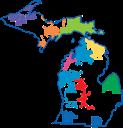
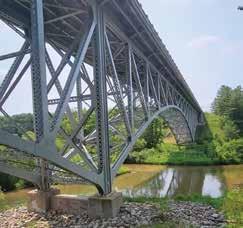


MI CO-OP Community
RECIPE CONTEST
See details on page 10. Favorite Fall Recipes, due Aug. 1; Best Holiday Mains, due Sept. 1 Win a $100 bill credit!
GUEST COLUMN
See details on page 18. Share your fondest memories and stories. Win $200 for stories published!
MYSTERY PHOTO
See details on page 18. Win a $100 bill credit!
To enter contests, submit reader content & more, visit countrylines.com/community
6 SPANNING THE MITTEN: MICHIGAN’S MOST ICONIC BRIDGES
Tracing our state's past through the bridges that built its future.
10 MI CO-OP KITCHEN
Sandwiches & Wraps: effortless to make, impossible to resist.
14 ROOTED IN FLAVOR
Michigan’s farm-to-table experience: where the land inspires the menu.
18 GUEST COLUMN
The Generational Dresses: A PIE&G member recounts how heirloom dresses stitched generations together.
BOARD OF DIRECTORS
Howard Bowersox, Chair, District 8 219-670-0977 hbowersox@glenergy.com
Janet Andersen, Vice Chair, District 6 231-690-4622 jandersen@glenergy.com
Paul Byl, Secretary, District 7 231-742-2643 pbyl@glenergy.com
Dale Farrier, Treasurer, District 5 231-564-0853 dfarrier@glenergy.com
Mark Carson, District 2 231-675-0561 mcarson@glenergy.com
David Coveyou, Director, District 1 231-347-4056 dcoveyou@glenergy.com
Richard Evans, Director, District 3 231-883-3146 revans@glenergy.com
John LaForge, Director, District 9 269-623-2284 jlaforge@glenergy.com
Mary O’Connell, Director, District 4 517-974-5797 moconnell@glenergy.com
PRESIDENT/CEO: Shaun Lamp 888-485-2537
BOYNE CITY HEADQUARTERS 1323 Boyne Ave. Boyne City, MI 49712
Call center hours: 7 a.m.–5:30 p.m. M–F Phone: 888-485-2537 Email: glenergy@glenergy.com
TO REPORT AN OUTAGE: Call 888-485-2537 or login to your account at gtlakes.com or the GLE mobile app.

Your Vote Is Your Voice
By Shaun Lamp, Great Lakes Energy President/CEO
The devastating ice storm that impacted GLE’s northern service area earlier this year illustrated the important role leadership plays in an organization’s success.
Strong leadership enabled us to respond to an unprecedented storm with grit and tenacity, and it will play an equally important role in the coming months and years as GLE continues to recover from the storm’s long-term impacts.
Built on the cooperative principle of democratic control, GLE’s leadership starts with our board of directors. The board is made up of nine directors who are nominated and elected from among the members in their respective districts. The board governs the cooperative and is actively involved in setting policies and making decisions that guide the organization.
Part of the value of being a cooperative member is that you, not GLE staff or other outside entities, determine who serves on the board. You can play a vital role in shaping the way your co-op is run. Qualifi ed members can run for a board seat, sign a candidate’s nominating petition, or simply vote.
Every member’s vote carries equal weight. Whether it’s a business with several owners, a home with a single owner, or a married couple, each primary account holder has one vote.
Board members serve three-year terms, and each year, three of the nine board seats are up for election. This year, voting will take place for seats in districts 6, 8, and 9. Members in those districts can read about their respective candidates in this issue of Country Lines and then cast their vote. For all other members, your opportunity to vote will come in 2026 or 2027.
for members to participate in the democratic process that shapes the face of their electric cooperative. In the 2024 election for districts 1, 2, and 7, more than two-thirds of the members who voted used the online voting option.
To ensure the election is conducted fairly and effi ciently, all voting will be administered by a third-party partner, Survey Balloting Systems (SBS). The ballot and instructions on how to vote are included on the cover wrap that accompanies this issue in voting districts. Be sure your vote is submitted before the election closes at 5 p.m. on Aug. 21. If you are using a mail-in ballot, be sure to allow enough time for it to arrive at SBS in Minnesota.
I highly encourage you to take advantage of this opportunity to have your voice heard.
It’s the cooperative difference.
Change of Address: 888-485-2537, ext. 8924 DISTRICTS BY
Great Lakes Energy is an equal opportunity provider and employer.
Two years ago, we began offering an online voting option in addition to a mail-in ballot to make it even easier
District 6 – Lake and Mason counties
District 8 – Clare, Mecosta, Newaygo, and Osceola counties
District 9 – Allegan, Barry, Kent, Montcalm, and Ottawa counties
Storm Recovery Costs Come Into Focus
It’s been a little more than three months since a devastating ice storm brought down trees and power lines, leaving more than 68,000 GLE members in northern Michigan without power, some for extended periods of time.
In the May issue of Country Lines, we shared some statistics to give you an idea of the magnitude of our storm response. Some of that data included:
• We replaced more than 3,100 poles.
• We had more than 1,500 line and tree personnel in the fi eld.
• We restored more than 4,300 miles of power lines.
• We established a storm camp to house 1,100 crew members.
• We used more than 133,000 gallons of fuel in the response.
Since that data was compiled in midApril, we have completed restoring service to all of our Truestream subscribers who were affected by the storm, and we are now well into our assessment and storm debris clean-up phase.
We now have a much clearer picture of the storm’s fi nancial impact on your cooperative.
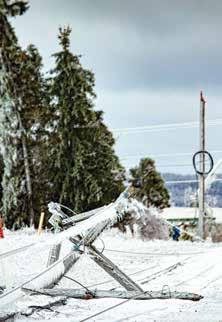
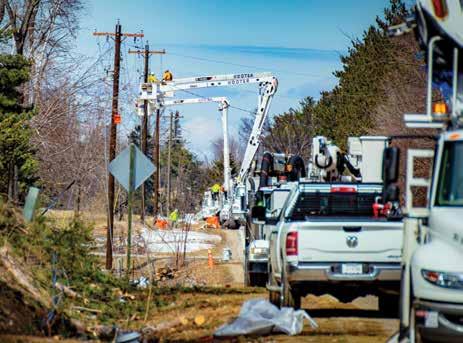
When factoring in all the costs, such as labor, materials, fuel, housing, vehicle maintenance, debris clean-up, regulatory compliance, and many others, we estimate the cost of the ice storm response will be more than 62 times our annual storm budget. Estimates for our stormrelated expenses are well over $100 million, with fi nal numbers still to be determined as we continue to remove debris and trees that are impacting our right-of-way.
Covering the costs
In the short term, GLE is covering these expenses with an emergency line of credit, but that also comes with significant interest costs that are not currently recoverable through any potential state or federal disaster relief.
As a not-for-profi t electric cooperative without any investors, GLE’s expenses are borne by the rates it charges. Those rates are based on our actual costs to provide service. All cooperative members share in these costs; thus, the impacts of the storm, if they come in the form of a rate increase, will be shared across the entire membership.
Although there are still many variables in the equation, one fact has become clear: GLE and its members will feel the storm’s fi nancial impact for a long time to come. The extent of that fi nancial impact will depend heavily on how much state and federal disaster relief funding GLE receives.
As of June 20, here is the status of the disaster relief funding:
• On May 15, Michigan Gov. Gretchen Whitmer submitted a major disaster declaration to the White House. The declaration request must be approved by President Trump to allow FEMA storm relief funding to start flowing to Michigan.
• On May 19, U.S. Senators Gary Peters and Elissa Slotkin, along with U.S. Rep. Jack Bergman, sent President Trump a letter of support for the federal disaster declaration.
While we await more information from state and federal officials on these funding requests, rest assured that GLE’s board of directors and leadership team are working tirelessly behind the scenes, fully focused on the best interests of GLE and our members.
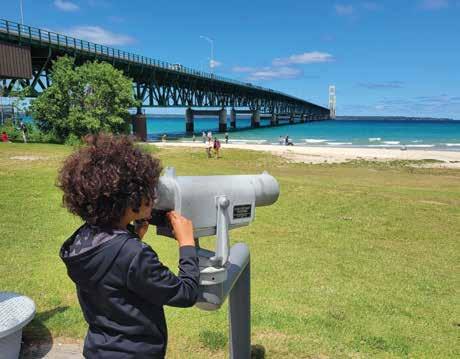
Spanning the Mitten Michigan’s Most Iconic Bridges
Michigan’s unique geography—with over 11,000 inland lakes, 120 major rivers, and borders on four Great Lakes—has made bridges essential to connecting people, peninsulas, and even countries. The state boasts more than 11,000 bridges, each with a distinct story and role in Michigan’s landscape.
International Bridges
Three major bridges connect Michigan to Canada. The Ambassador Bridge , opened in 1929, links Detroit and Windsor and remains the busiest international land border crossing in North America.
The Blue Water Bridge , built in 1938 and twinned in 1997, connects Port Huron to Sarnia, Ontario.
In the Upper Peninsula, the Sault Ste. Marie International Bridge spans the St. Mary’s River, linking the twin cities of Sault Ste. Marie in Michigan and Ontario. The bridge overlooks the Soo Locks, a critical shipping passage between Lake Superior and the lower Great Lakes.
Iconic Michigan Spans
The most famous bridge in Michigan is the Mackinac Bridge , also known as “Mighty Mac” or “Big Mac.” Opened in 1957, it spans fi ve miles across the Straits of Mackinac, linking Michigan’s upper and lower peninsulas. It remains one of the longest suspension bridges in the Western Hemisphere.
Opened in 1959, the Portage Lake Lift Bridge connects Houghton and Hancock in the Upper Peninsula. It’s the world’s heaviest and widest double-deck vertical lift bridge. In winter, its lower deck is lowered for snowmobiles while vehicles continue on the upper level.
Miniature and Replica Bridges
Several pedestrian bridges celebrate the Mighty Mac. In St. Louis, the 120-foot Mini Mac Bridge spans a pond shaped like the Lower Peninsula.
In Reed City’s Rambadt Park, the Little Mac Bridge is a 150-foot-long wooden suspension bridge crossing the Hersey River.
Near Mesick, the Little Mac Footbridge —at 246 feet—is the longest wooden suspension bridge in the Lower Peninsula and links the Manistee River Trail with the North Country Trail.
Parks with Notable Bridges
Historic Bridge Park in Battle Creek features restored 19th- and early 20th-century truss bridges, picnic areas, trails, and educational displays.
McCourtie Park in Cement City has 17 whimsical concrete bridges designed in faux bois style, mimicking wood textures. The park sits on the former estate of cement magnate W.H.L. McCourtie.
In Croswell, the Swinging Bridge built in 1905—is a 139-foot pedestrian bridge made of wire cables and wooden planks. It was originally constructed by the Michigan Sugar Company for worker access.
Deerfi eld Nature Park in Isabella County includes four bridges: two swinging suspension bridges, the Lewis Pontiac Bridge, and the Fisher Annex Covered Bridge, which was rebuilt after a 1995 fi re.
Covered Bridges
Michigan is home to several historical covered bridges. White’s Covered Bridge , built in 1867 over the Flat River near Smyrna, was rebuilt after a 2013 fi re.
The Ada Covered Bridge , also erected in 1867, spans the Thornapple River and was restored in 1979.
Mackinac Bridge
North of Lowell, the Fallasburg Covered Bridge (1871) is part of a preserved historic village and is still open to vehicle traffi c.
The Langley Covered Bridge , built in 1887 near Centreville, is the longest covered bridge in Michigan at 282 feet and remains open to vehicles.
In the 1960s, Pierce Stocking designed a scenic bridge that’s now part of the Sleeping Bear Dunes National Lakeshore. It was reconstructed in 1986.
In Frankenmuth, the Holz Brucke Covered Bridge (1979) crosses the Cass River and is open to both vehicles and pedestrians, complementing the town’s Bavarian charm.
Unique and Scenic Crossings
In Midland, The Tridge is a threeway wooden footbridge built in 1981 where the Chippewa and Tittabawassee Rivers meet, linking three parks and paths.
At Boyne Mountain, the SkyBridge is the world’s longest timbertowered suspension bridge at 1,200 feet. It includes a glass fl oor section suspended 118 feet above a forested valley.
The Cut River Bridge , a cantilevered deck truss bridge along US-2 in the Upper Peninsula, towers 147 feet above the gorge. Trails and 230 stairs below lead to the Lake Michigan shoreline.
The Cooley Bridge in Manistee County spans the Pine River at 613 feet and 95 feet high. Built in 1934, it was recognized for its beauty and includes picnic areas and stairways to the river.


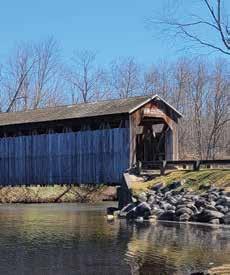
Whether they’re soaring above rivers, swaying beneath your feet, or tucked into scenic parks, Michigan’s bridges are more than just pathways—they’re part of our state’s charm, history, and adventure. So, next time you’re roadtripping or hiking, keep an eye out— you never know when you’ll stumble upon one of these architectural gems spanning the mitten.
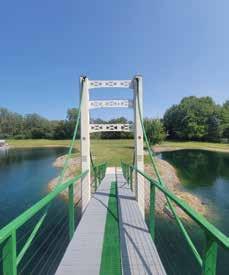
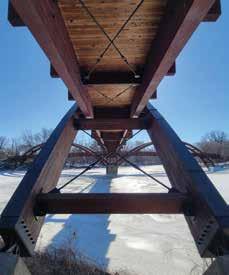
Cassondra Scott is a content creator, writer, and social media influencer at Cassondra Wanders— sharing small businesses and sights to see all over the state of Michigan.
Scan the QR code to watch a video of our Bridge Tour.
Sault Ste. Marie International Bridge
Fallasburg Covered Bridge, Lowell
Mini Mac Bridge, St. Louis
The Tridge, Midland
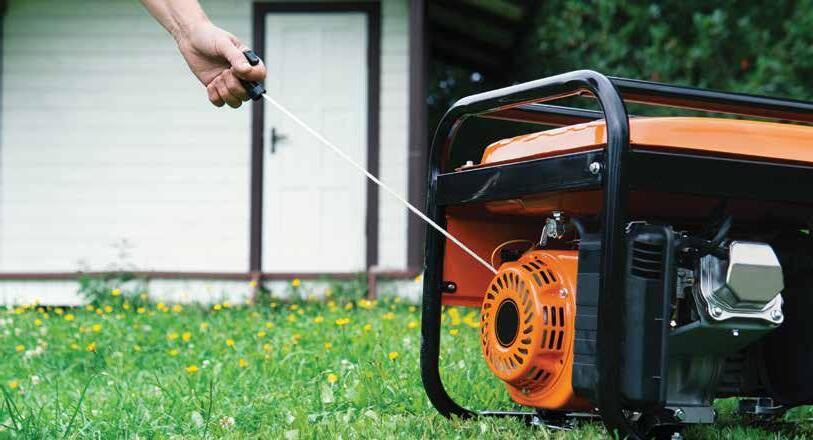
Sign Up For Generator Safety
The ice storm that caused extensive damage to the northern portions of our service area earlier this year clearly illustrated the benefits that a generator can offer for members during a power outage.
Although GLE always works hard to ensure service reliability and restore power to our members as quickly and safely as possible when outages do occur, sometimes major storms can lead to outages that last hours or days. In these situations, a generator can help keep the lights on and essential appliances running until your power is restored. For less than $1,000, a portable generator can provide just enough power to keep some essentials running. For a more sizable investment, a standby generator can automatically turn on to provide nearly all your home’s electric needs until electric service is restored.
While having a generator can be a blessing in the event of a power outage, it’s important that you are aware of several very important safety considerations ahead of time. It could be a matter of life and death.
Let us know!
If you’ve had a generator for a long time or if the recent ice storm prompted you to invest in one, please be sure to let us know by calling (888) 485-2537 or emailing glenergy@glenergy.com so we can add a note to your account.
Please note: Generator account notations are made to enhance the safety of our lineworkers and are not a factor in our restoration process.
Use a transfer switch
If you plan to connect a generator to your home’s electrical system, it is very important that you use a transfer switch to isolate your home’s wiring from the outside electrical grid.
If you don’t already have one, contact a licensed electrician to ensure a quality transfer switch is safely installed. There are two reasons why it’s important to use a transfer switch while your generator is in use:
• Prevent electric shock risk to lineworkers and others: A transfer switch prevents electricity from a generator connected to a home’s wiring from fl owing back into the power lines and endangering the lives of our crews working to restore your power and others who may encounter a downed line. Always assume a downed power line is energized and keep clear.
• Avoid damage to home appliances and electronics: Using a transfer switch when a generator is supplying power to your home will also prevent damage to electronics and appliances that could happen if power from Great Lakes Energy is restored while the generator is still running.
Avoid fire risks
Be sure not to overload your generator, especially for portable models. This can lead to overheating and pose a fi re hazard. Also, do not refuel the generator until it has cooled off. If you don’t wait, you could cause an explosion.
Beware of deadly carbon monoxide poisoning
Operate a portable generator outdoors at least 25 feet away from the house and away from doors, windows, and vents.
To watch a video with more generator safety information, visit gtlakes.com/generators or scan the QR code.

MICHIGAN’S WATERFALLS
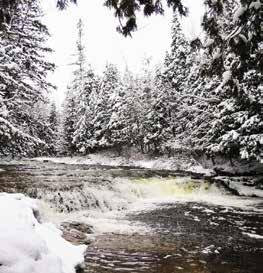

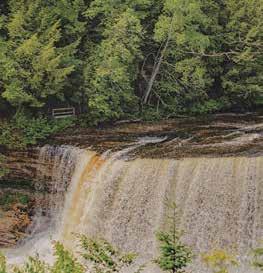
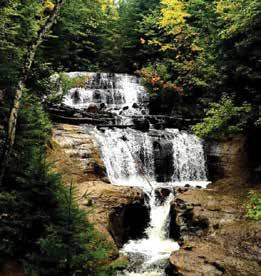
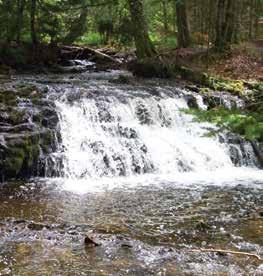
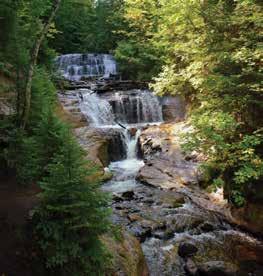
1. MOST VOTES Ocqueoc Falls—Presque Isle County, Karen Brown, Shelby
2. Sable Falls, Katrina Sweet, Elmira
3. Tahquamenon Falls, Dawn Humy, Ravenna
4. Chasing waterfalls and capturing memories, Alesha Miller, Ludington
5. Tahquamenon Falls, Beth Pipe, Baldwin
6. Beautiful Sable Falls in Grand Marais, Christopher Mathia, Kalkaska
Enter to win a $200 energy bill credit!
Submit Your “Michigan’s Bridges” Photos By Aug. 25 for the October issue! Each month, members can submit photos on our website for our photo contest. The photo with the most votes is published here, along with other selections.
How To Enter: Enter the contest at gtlakes.com/ photocontest/. Make sure to vote and encourage others to vote for you, too. The photo receiving the most votes will be printed in an issue of Michigan Country Lines along with other favorites. All photos printed in the magazine in 2025 will be entered into a drawing to win a $200 bill credit in December 2025.
SANDWICHES & WRAPS
Effortless to make, impossible to resist—perfect bites for any time of day.

WINNING RECIPE!
SUMMER HERB CHICKEN SALAD WRAPS
Rachel Smith, Midwest Energy
1 pound skin-on/bone-in chicken breasts or thighs
2 teaspoons salt (to season chicken)
2 teaspoons freshly ground black pepper (to season chicken)
1 tablespoon olive oil
½ cup mayonnaise
1 tablespoon Dijon mustard
2 green onions, thinly sliced 1–2 celery stalks, fi nely chopped
1 tablespoon fresh dill, minced
1 tablespoon fresh basil, minced
½ teaspoon fresh tarragon, minced (optional)
4 large tortillas
• romaine lettuce, roughly chopped
Preheat oven to 350 F. Prepare a baking sheet covered in parchment paper. Add the chicken to the baking sheet and season well with salt and pepper; make sure to get under the skin and on all sides. Drizzle with olive oil. Roast in the oven (35–40 minutes for chicken breasts, or 45–55 minutes for chicken thighs), until internal temperature reaches 155 F. Remove from oven, transfer to plate, and allow to cool for 15 minutes. (Note: By removing at 155 F, the temperature will continue to rise with carry-over cooking.) Once cool enough to handle, remove the meat from skin and bones. Cut up into pieces about ½–¾ inches thick. In a bowl, combine the mayonnaise, Dijon mustard, green onions, celery, dill, basil, and tarragon. Add the chicken pieces. Slowly stir ingredients together. Add additional salt and pepper to taste. Place in the fridge for 2 hours before serving. Or, if serving right away, place the bowl in the freezer for 15 minutes to allow it to chill. Spoon chicken salad mixture onto tortillas and top with romaine. Roll up. Makes about 2 cups chicken salad. You can easily double recipe.
Watch a video of this month’s winning recipe at micoopkitchen.com/videos
RECIPE CONTEST Win a $100 energy bill credit!
Favorite Fall Recipes, due Aug. 1; Best Holiday Mains, due Sept. 1. Submit your favorite recipe for a chance to win a $100 bill credit and have your recipe featured in Country Lines with a photo and a video. Submit your recipe at micoopkitchen.com, or send it via email (include your full name and co-op) to recipes@countrylines.com


MINI HAM SANDWICHES
Deanne Quain, Great Lakes Energy
12 King’s Hawaiian Sweet Dinner Rolls
1 pound deli ham, shaved
½ pound Swiss cheese
1 stick butter
1 tablespoon Worcestershire sauce
1 tablespoon poppy seeds
2 tablespoons brown sugar
1 tablespoon Jack Daniel Dijon mustard
Preheat oven to 350 F. Cut entire pack of rolls horizontally. In a 9x13-inch baking dish, place bottom halves of rolls evenly. Cover with ham and cheese and place top halves of rolls on top. To a medium saucepan over medium heat, add the butter and melt. Add the Worcestershire sauce, poppy seeds, brown sugar, and mustard, and heat while stirring. Pour liquid over sandwiches and bake covered for 20 minutes, or until the cheese melts. Makes 12 sandwiches.

BAKED MONTE CRISTO SANDWICH
Mary Ellen Wynes, Homeworks Tri-County
2 eggs
2 tablespoons milk
1 teaspoon vanilla extract
4 slices bread
½ pound sliced baked ham
½ ounce Gruyere or Swiss cheese slices
¼ cup strawberry jam
• powdered sugar, for serving
Preheat oven to 450 F. Prepare a baking sheet covered in parchment paper. In a shallow dish (large enough to fi t a sandwich), beat the eggs with the milk and vanilla. Set aside. Assemble two slices of the bread with ham and cheese. Spread the other two slices with strawberry jam. Slightly compress sandwich. Dip both sides of the sandwich in the egg wash for 5 seconds on each side.
Transfer to the baking sheet. Bake 6 minutes, fl ip, and bake 5 more minutes, until browned and the cheese has melted. Sprinkle with powdered sugar before serving.

WARM TURKEY PESTO SANDWICHES
Mary Card, Great Lakes Energy
6 burger or sub buns
6 slices deli turkey meat
6 slices provolone cheese
3 tablespoons prepared basil pesto
3 tablespoons mayonnaise
1 tablespoon melted butter
Preheat oven to 400 F. Line a rimmed baking sheet with foil or parchment paper. Separate the burger or sub buns. Fold the turkey and cheese to fi t the bottom of buns, tearing or cutting to fi t. In a small bowl, combine the basil pesto and mayonnaise; stir until combined. Spread a thin layer over the six bun tops. Place bun tops on and transfer the sandwiches to the baking sheet. Brush tops with melted butter and heat 8–10 minutes or until cheese melts. Serves 6.

SOUTHWEST CHICKEN PANINI
Nancy Popa, Cherryland Electric
2 cups fresh cilantro, leaves and stems, loosely packed
3–4 garlic cloves, minced
1 jalapeño, seeded and fi nely chopped
• juice of ½ lime
⅛ teaspoon salt
2 tablespoons olive oil
¼ cup mayonnaise
1 tablespoon canned chipotle chili in adobo, minced
½ teaspoon sugar
4 slices hearty white or wheat
sourdough bread, ½″ per slice
¼ cup butter, softened
2 ounces pepper jack or Havarti cheese, thinly sliced
3 ounces rotisserie chicken, torn into large pieces
In a food processor, blend cilantro, garlic, jalapeño, lime juice, and salt. Slowly add oil to form a pesto paste. In a small bowl, mix mayonnaise, chipotle chili, and sugar. Lightly butter the outside of each bread slice. Spread mayo on two slices and pesto on the other two. Top pesto sides with cheese and chicken, then close with mayo slices. Grill in a panini press or skillet for 3–4 minutes, checking for doneness. Makes 2 paninis.
BOARD OF DIRECTORS CANDIDATES
DISTRICT 8 — CLARE, MECOSTA, NEWAYGO, AND OSCEOLA COUNTIES

Occupation:
• Retired engineer/manager/high school teacher
• Cooperative member for 14 years
• Cooperative board member for six years
Why are you seeking a board seat?
You have supported me for six years as your board representative. The Directors chose me as board chair for the last three years, a privilege I take seriously.
As a member, like you, my family’s priorities regarding electricity are reliability, affordability, and sustainability.
A group outside our service area is recruiting representatives to meet a special agenda for renewables. These technologies contribute to a balanced energy mix but alone are more costly and less reliable Their goal appears to be influencing your cooperative board. A concerned GLE member recently shared a copy of the group’s recruitment letter with me.
This outside group can only be successful with low voter turnout, which is unfortunately common for our elections. The dynamics of today’s electric industry create challenges, but also abundant opportunities.
Do you have energy industry experience, including work as a Great Lakes Energy employee, electric utility contractor, or at another energy service provider?
As plant engineer and later plant manager of the Hardy Salt Company facility in Manistee, Michigan, from 1979 to 1988, I had responsibility for the cogeneration of steam and electricity for this large salt manufacturing facility.
As a GLE Director for six years, I achieved and maintained the highest level of National Rural Electric Cooperative Association certification to remain informed of industry trends and best practices.
Please list any organizations that you belong to or volunteer work that you participate in:
• Current Chair Mecosta Township Planning Commission and ZBA for 12 years
• Personal Finance Coach leading Ramsey Personal Finance programs for adults and high school students
List other qualifications and relevant information:
• Bachelor’s degree in chemical engineering
• Engineer and Manager
• Leadership positions in a 950-residence property owners’ association
• Small business owner
• President of a local credit union board, White Lake Area

CLE AN U P WITH AN E NE RGY WISE RE BATE
Our Energy Wise program can help you cut more than the costs associated with upgrading to more energy-e cient products and systems for the inside of your home
It can help you clean up around your home as well by o ering rebates on
th e purchase of many elec tric- powe re d outdoor lawn and garde n tools
In addition to re bates on elec tric- powe re d lawn mowe rs , trim m e rs , and leaf blowe rs , this year we’ve adde d a $ 40 rebate o n elec t ric ch a ins aws
To learn more about th e outdoor e quipm e nt and many othe r re bates available through th e Ene rgy Wise program , visit gt la kes co m/en ergy- wise today!



Howard Bowersox
Andrew (Drew) Laughlin

Occupation:
• Cybersecurity advisor
• Cooperative member for eight years
Why are you seeking a board seat?
I am seeking a seat in order to bring my forward-looking knowledge and relevant experience in identifying and managing risk to the Great Lakes Energy Board of Directors.
Do you have energy industry experience, including work as a Great Lakes Energy employee, electric utility contractor, or at another energy service provider?
I have six years of experience with an electricity generation and transmission utility as a cybersecurity professional. I focused on developing a culture of cybersecurity awareness while staying ahead of the latest threats to critical infrastructure.
Please list any organizations that you belong to or volunteer work that you participate in:
• I am currently the chairman of the planning commission of Winterfield Township.
• I am an active member of the International Information System Security Certification Consortium (ISC2).
List other qualifications and relevant information:
I currently hold an active Certified Information Systems Security Professional designation (CISSP), demonstrating my ability to identify and assess business risk.
VOTE!
As a member and owner of an electric cooperative, you decide who will represent you on the Great Lakes Energy Cooperative Board of Directors.

*Director candidates are
Rooted in Flavor
Michigan’s Farm-to-Table Experience
Where the Land Inspires the Menu
By Emily Haines Lloyd
The farm-to-table movement runs deep in Michigan, where a rich agricultural landscape meets a strong spirit of collaboration between farms and restaurants. Across the state, many establishments don’t just partner with local growers—they are the growers, operating their own farms to ensure every ingredient is fresh, seasonal, and full of Michigan flavor.
You don’t have to look far to fi nd great examples—some are right within our electric cooperative communities.

Farm Club farmclubtc.com

Farm Club: Growing Connection in Traverse City
A member of Cherryland Electric Cooperative, Farm Club near Traverse City is more than just a restaurant—it’s a farm, a bakery, a brewery, and a community gathering place. Here, chefs build their menus around what’s ripe in their fi elds, shaping meals that refl ect the rhythm of the seasons. Heirloom beans simmer into rich soups, and just-picked corn becomes a fragrant pozole. Everything is guided by the land’s natural cadence.
A Taste of Place
This hyper-local approach embraces the concept of terroir—the idea that flavor is shaped by the environment. Soil, water, and climate combine to give ingredients a distinct character, and in Michigan, that character is unmistakable. From juicy summer berries to earthy autumn squash, our state’s seasonal bounty inspires menus that evolve with the harvest.
In Suttons Bay, another Cherryland Electric member, 9 Bean Rows, exemplifi es this connection to place. Part farm, part bakery, and part café, the business grows its own produce, bakes artisanal

bread on-site, and runs community programs that promote healthy eating. Their signature sourdough and sea salt fennel loaves embody the taste of Michigan—right down to the well water used in the baking process.
Pond Hill Farm: A Full-Sensory Experience
On 238 scenic acres near Harbor Springs, Pond Hill Farm—a Great Lakes Energy member—offers an immersive farm-to-table experience. Visitors can tour the fi elds, sample beer and wine crafted from the farm’s own hops and grapes, and savor wood-fi red pizza made with fresh, homegrown ingredients. Even in winter, Pond Hill keeps the connection strong with intimate supper clubs featuring root vegetables and greens harvested from heated hoophouses.
But Pond Hill’s mission goes beyond food. From barnyard animals to seasonal festivals, the farm invites guests of all ages to engage with agriculture fi rsthand and experience the work— and wonder—behind every meal.
Food That Builds Community
In Michigan, farm-to-table isn’t just about eating well—it’s about creating stronger, more connected communities. By sourcing ingredients locally, restaurants support nearby farmers, strengthen regional economies, and create welcoming spaces where people come together.
At 9 Bean Rows, the impact extends into schools. Their food program supplies fresh produce to students in Leelanau County and Traverse City, introducing young people to nutritious, local food and helping them understand where it comes from.
Similarly, Farm Club and Pond Hill Farm host events like farm tours, pizza nights, and seasonal dinners, transforming food into a shared experience that brings neighbors, families, and visitors together.
More Than a Meal
In Michigan, farm-to-table is more than a dining trend—it’s a celebration of land, people, and place. It’s about honoring farmers, cultivating community, and creating food that’s rooted in care and connection.
Every dish tells a story—of the soil that nourished it, the hands that harvested it, and the community that gathers around it.
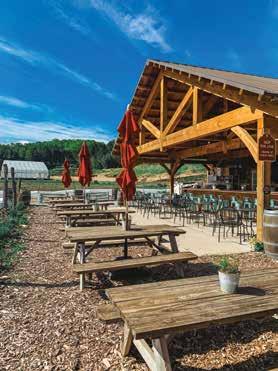

“ IN MICHIGAN, FARM-TO-TABLE ISN’T JUST ABOUT EATING WELL—IT’S ABOUT CREATING STRONGER, MORE CONNECTED COMMUNITIES.”
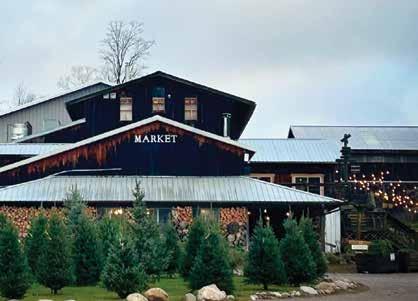

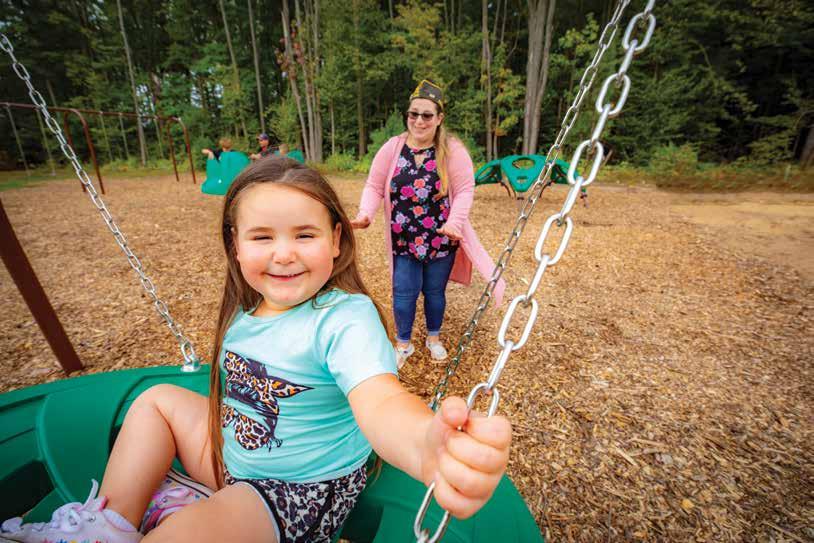
People Fund Helps VFW Offer Fun For All
Playgrounds are great places for children and families from all walks of life to spend time together, have fun, and make memories.
But not all playgrounds are created equal when it comes to accessibility.
Thanks to the efforts of an organizing committee, dedicated volunteers, generous donors, and several grants—including a recent one from Great Lakes Energy’s People Fund—the Gaylord area is well on its way to having a playground that will offer fun for all, including people with mobility limitations.
Courtney Willits, a member of the Gaylord VFW Post 1518 Auxiliary and a member of a three-person committee heading up an effort to build the Veterans Community Park Playscape, said the playground is part of the post’s larger Veterans Community Park project, which has been underway since 2017.
Thanks to earlier VFW efforts, the park, located at 1905 S. Otsego Ave. in Gaylord, already has an events
pavilion and a landscaped flag-lined entrance. It will eventually also be the site of a new building to serve as the post’s home.
Courtney said that about seven years ago, as plans for the park were coming together, the VFW post commander came to her with an idea from the post’s membership to build a playground to complement the planned features for the park property.
Although children are the primary users of playgrounds, the idea to make this playground accessible for people with physical disabilities initially grew out of a desire to make it easier for post members who have mobility issues to enjoy the playground with their grandchildren.
Courtney said as planning continued, the committee discovered that there weren’t any playgrounds designed for people with disabilities in the Gaylord area.
“We got to thinking about it and realized that there’s nothing like this in our area,” Courtney said. “It’s really an unmet need.”
In fact, she pointed to 2022 census data that show about 12% of people in Otsego County under the age of 65 have a disability. For the city of Gaylord, that percentage jumps to more than 21%.
Thanks in part to a $5,000 grant from the People Fund, the fi rst of the four planned phases of the playground was installed in August with the help of many volunteers.
The fi rst phase, which cost about $54,000, included installing many of the stand-alone playground pieces that will make up the 100-by-70-foot playscape. The next two phases will include installing the main barrier-free play structure, and the fi nal phase will involve pouring a special rubberized surface for the entire playground area.
Courtney said the rubberized surface is especially important because it offers enough cushioning to enhance safety while still providing a smooth, stable surface for walkers, canes, and wheelchairs.
In the meantime, much like many playgrounds, woodchips will serve as the temporary playground surface.
Courtney said fundraising is already underway for the next phases, which are expected to cost an additional $450,000. In fact, thanks to additional funding that came through in May, construction on the second phase of the project is expected to begin this fall.
Following the positive feedback the committee has received on the fi rst phase of the project, Courtney said excitement is high to complete the playground’s remaining phases.
“We think the playground will be a great asset for more than just people who live in the Gaylord area,” Courtney said. “I fully expect the playground will draw families who don’t have access to this type of opportunity in their own community.”

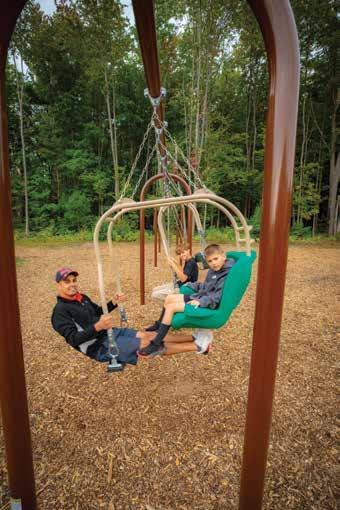
Anyone who would like to support the playground effort—either fi nancially, or by volunteering— may contact Courtney at (616) 970-1073. More information about the Gaylord VFW Post and its many projects and activities can be found online at vfw1518.org/. Updates are also regularly posted on the organization’s Facebook page: facebook.com/Post1518
Since its inception in 1999, Great Lakes Energy’s People Fund has awarded more than $5 million in grants to nonprofit organizations that serve GLE’s 26-county service area. Grants are funded by participating GLE members who agree to have their monthly electric bill rounded up to the next whole dollar. To learn more about the People Fund, including how to sign up, how nonprofit organizations can apply for a grant, and a list of recent grant recipients, visit gtlakes.com/people-fund.
Where In Michigan Is This?
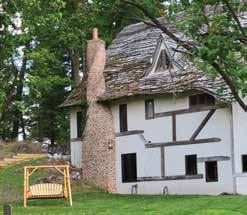
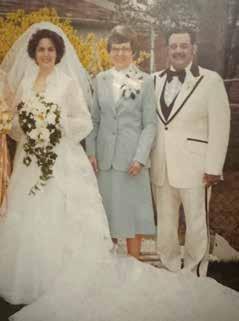
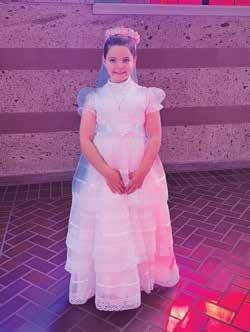
MYSTERY PHOTO
Win a $100 energy bill credit! Identify the correct location of the photo above by July 25 and be entered into a drawing to win a $100 electric bill credit. Enter your guess at countrylines.com/community
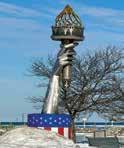
May 2025 WINNER!
Our Mystery Photo winner is Debra Anthony, a Thumb Electric Cooperative member who correctly identified the photo as the Statue of Liberty Torch Sculpture in Rogers City, Michigan. Winners are announced in the following issues of Country Lines: January, March, May, July/August, September, and November/December.
The Generational Dresses
By Sharon Libich, a Presque Isle Electric & Gas Co-op member
In 1978, I found my wedding dress in the pages of bridal magazines— a far cry from today’s online searches. I never imagined that decades later, its delicate train would become part of my granddaughter’s First Holy Communion dress.
Family tradition has always been woven into the fabric of our lives. My godmother hand-sewed my Christening gown in 1959. That same dress was worn by my daughters in 1981 and 1987, and again by my granddaughter Hailey when she was born in 2015.
Our Communion dress holds a similar legacy. I wore it in 1967, my daughters in 1988 and 1994, and Hailey in 2022. Wanting a full-length dress, she asked for something special—and I knew just what to do. I carefully repurposed the 5-foot train from my wedding gown.
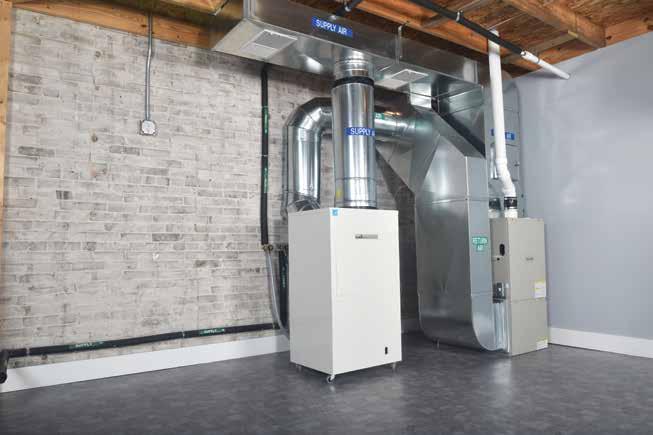
Reassembling the dress was truly a labor of love, but seeing Hailey in it made every stitch worth it. The tradition continues—and the dress lives on.
GUEST COLUMN Win $200 for stories published! Share your fondest memories and stories. Win $200 for stories published. Visit countrylines.com/community to submit.
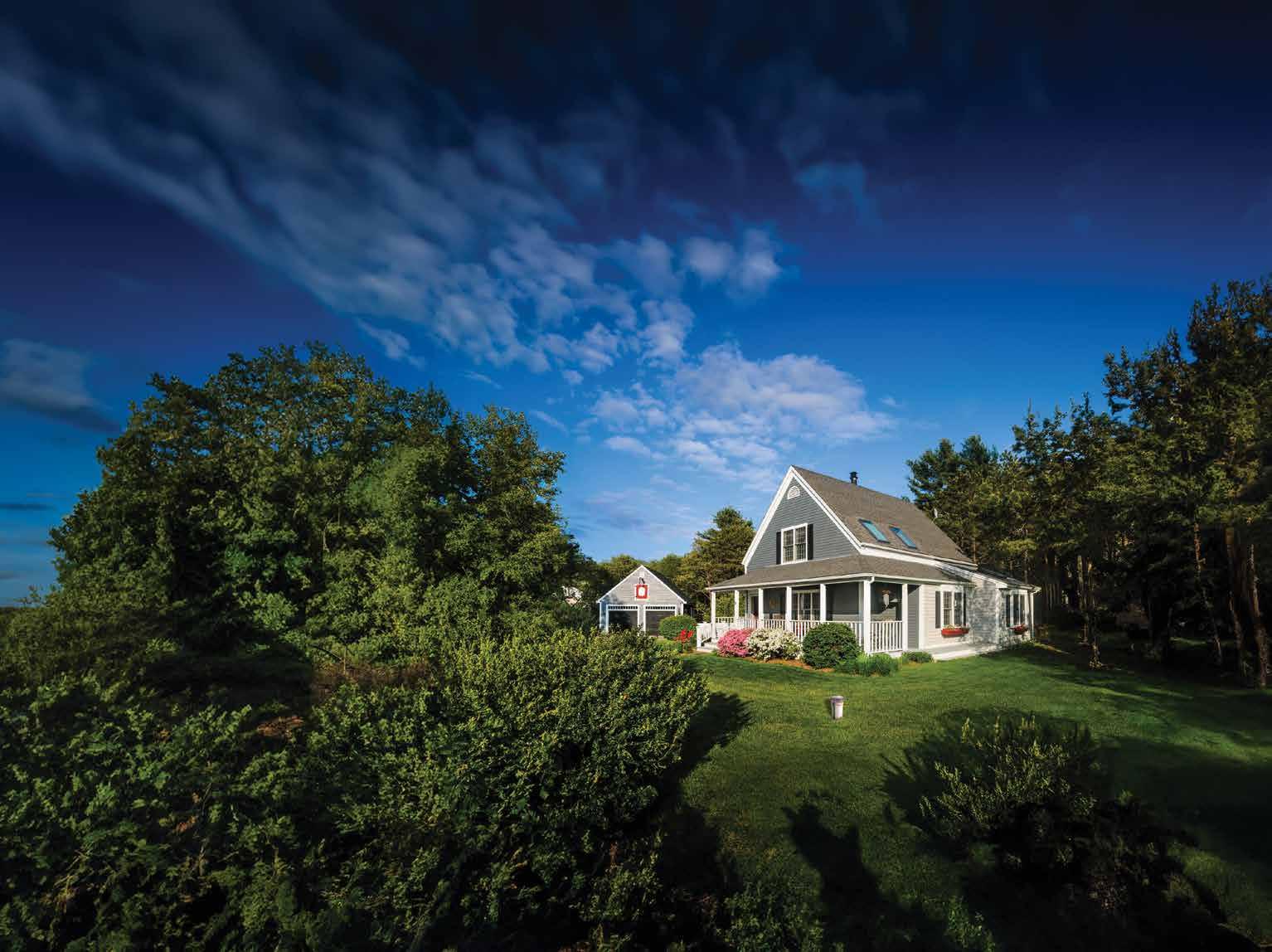



Well-Connect is a water source heat pump that is added to your existing furnace in as little as 1 day. This patented, hybrid approach minimizes the up-front cost of the system and maximizes the comfort & savings.






